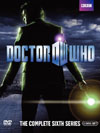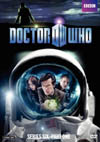DVD Extras (box sets only) include:
No doubt regular readers will have noted my rants on how predictable the stories had become, in the sense that you could just look at where they fell within the season and easily predict what would happen and what the quality of the story would be. The usual pattern was:
The Loud Structure of SilenceThere's a ton of good stuff in the two-part opener for the season, resulting in a lot of great scenes and sequences. The downside is, the minute you look away from this story, you'll forget what actually held the plot together.
Indeed, since the protagonists forget their opponents immediately after looking away, they're not going to move their side of the narrative forward much each time they meet them. Perhaps the bathroom scene near the beginning revealed too much too fast, and left no room to build from there. Of course, further encounters could move the Silents' side of the narrative forward, but there never really is much sense of what they are trying to accomplish or why. That's held back for mystery. Thus, even though we get a ton of cool stuff in the story, our investment in the scene to scene struggles is minimal at best. The audience gets passive, waiting for something to show up that makes sense. At least River Song's mysteries have already been well established, and just seeing her on screen primes us to be ready for another new revelation at any moment. The mystery would definitely be stronger if the audience hadn't got the bathroom scene in its entirety so early on. Indeed, it's a dangerous thing to let your protagonists fall too far behind the audience in terms of what they know and understand, one of the chief problems of both "The Horns of Nimon" (story no. 108) and "Evolution of the Daleks" (story no. 186), and each encounter with a Silent is likely to expand on this. Indeed, once you've seen the Silents in the light of the White House, fully conversant with Amy, and with their appearance compared to a "Star Trek mask" on screen, they're not going to be too effective creeping around the shadows in underground tunnels afterward. And demonstrating their power to destroy someone is important if they're going to spend the rest of the story bossing people around like the Daleks are often seen to do, and the people need to see this mechanism to bring their motivation in line. "Evolution of the Daleks" Part One completely missed that, and was worse off for it. But this story doesn't need that, thanks to its memory-edit hypnotism thing, and the Silents' electrical powers would probably have been better preserved for an episode cliffhanger reveal. In fact, the very nature of the Silents makes it seem obvious that proper conversational scenes with them should be held back for half a story, while only scene fragments leak through to audience and protagonists alike as they struggle to recover lost bits of their memories.
High Noon from the MoonThe first large chunk of this story is largely a set-up and hook for the entire season. In many ways it works really well. You'll spend thirteen episodes wondering how they're eventually going to get out of that pickle, coming up with more theories than can possibly be used. The sequence also gets an A+ for unique and bizarre imagery. Of course, this opening also delves deep into temporal theory that is not completely thought out properly, as the discussions can't see far past the outdated idea of the single re-writeable line of time, and end up reaching even farther for reasons why it can't actually be rewritten this time. This is old Moffat territory that would normally be due for retirement by now. Chiefly what allows him to get away with it is the fact that this very sort of temporal misalignment is a core part of our long term situation with River Song's character, and she's a great character representing one of the best long-term mysteries Doctor Who ever had. For her sake, we'll be prepared to go with it and dig deeper into it.One curious subject that becomes very important here is the Doctor's age. Most of New Millennium Who has grated excruciatingly against the steady build-up during the classic series, from a 450-year-old second Doctor, to a 750-year-old fourth Doctor, to a seventh Doctor who started out at 953 years old in his first story. Why the new team fixated on impossibly limiting the ninth, tenth, and eleventh Doctors to specific ages between 900 and 908 always made me think they had their heads in the sand. So it was extremely refreshing to hear that the latest Doctor was now 1103 - finally something I could go with. But that was short lived, and we quickly reverted to one at around 909. Arrgghh! Not quite the clean break I'd have wished for, but at least we know we're headed for improvement. I do hope the Doctor recovers some memories of being in his Colin Baker persona at that age, and unearths some reason for forgetting a few hundred years of his life somewhere. Next temporal question: Does it really make sense for River Song to help investigate a mystery to which she already knows the answers? You'd think she'd rather just smile cheekily, say "Spoilers" in her usual admonishing tone, and teleport out. In fact, it isn't going to be easy to figure out what order she does experience her stories in anymore. The season opener attempts to simplify this to say that it's always the exact opposite to the order in which we see the Doctor moving through them, but that doesn't really seem to ring 100% true in terms of what she knows and what truly surprises or shocks her. And if we don't know how much she knows and what she actually still seeks to learn, it makes it harder for the audience to invest emotionally in her part of the investigations. And for that matter, Amy and Rory have a more confusing journey through the season as well. In the episodes written by Moffat, they seem to be living on Earth independently of the Doctor and his TARDIS, yet the stories written by everyone else simply treat them as typical TARDIS travelers. Plus, you could easily be led to believe that they experience this opener in Utah last of all.
What, you're leaving Nixon out of the conspiracy?Well, we're stuck on Earth again for two episodes and fussing with Earth governments, but I'm going to cut this story some significant slack because they make the effort to go to America both story-wise and production-wise, AND they use this to concoct a truly rich atmosphere of conspiracy akin to that of "The X-Files". I don't think you could possibly do this thing justice in England with British governments, and it definitely would have felt like a re-run if they had. Plus, the Silents are like the ultimate Men in Black. There are a lot of archetypal threads being plucked here. Good stuff.The story goes a bit against the natural grain to create a conspiracy in America with President Nixon on the outside of it looking in alongside our protagonists. Here he is an innocent and a good guy. Bizarre - and completely against stereotype. Though this take isn't my preference, we have to give Moffat his due for making it work really well. Actor Stuart Milligan does a fine job in the role as well, making it convincingly Nixon. Nice. The White House portions of the first episode are some of its best, and the plot still feels fairly strong here although it is starting to dissipate. The humour is still so entertaining that it keeps us roped in really well. Sections in the Florida warehouse at the junction of the three streets start out well enough, until the protagonists split up and get distracted by ideas that might best have been played out in other locations. It's easy to forget why they came here or what they hope to discover or accomplish, and the story feels a bit padded here, as though we're just waiting for a cliffhanger. We actually get a double-cliffhanger here. River and Rory are getting surrounded by Silents in an underground control room.... something that turns out to be forgettable for so many reasons, not least of which is the long time between the end of this scene and the actual end of the episode. The main cliffhanger is for the Doctor and Amy, and is brilliant in endangering a guest character instead of the indestructible regulars. However, the editing lacks a certain punch, as you can't tell if the bullet is supposed to be in slow motion or not, and the outcome doesn't seem to be in as much question as was intended. What probably sinks this cliffhanger in the long term is that the narrative is so keen to forget it and move on in the next episode. Indeed, the opening of part two is an ultra-dense all-over-the-place sequence that can't possibly do justice to all the brilliant ideas and character twists crammed into it. And while making us feel cheated out of getting answers and solutions to the cliffhanger, the cliffhanger itself loses most of its power, particularly for those of us watching the episodes for the first time back to back on DVD. And in the end, we have to look back on episode two's opening and wonder why the hell any of it happened. Why are our protagonists bothering with such an elaborate scheme to fool the army and the authorities, considering that they have Nixon himself on their side? And when you think about it, both the long sequence in the Florida warehouse and the long sequence in the orphanage are *supposedly* motivated to find the little girl and/or learn more about her. Cutting away from the Florida part just as they find her seems idiotic, and makes us not want to invest in looking for her all over again in another dark depressing setting. The shenanigans in the closed-down orphanage also seem quite slow, where it's easy to lose track of what our friends hope to accomplish here. With time being wasted here and in the Florida warehouse, the business of episode two's pre-title sequence should have been more free to use that time instead. And I think if investigation of the little girl wants to be so paramount to the narrative thrust, we need to have more of her in the story, or more answers and conversation that discuss her. We also have to wonder why the protagonists stop searching for those answers arbitrarily at the end of the two episodes as well. The TARDIS is quite busy in this one, although spends most of its time in the background. While most of the other characters get very unusual but most often effective entrances, the TARDIS has to wait until the White House sequences, where it too gets its due with a very unusual entrance to the foreground of the story. Today's style isn't my normal preference, but I like it for variety. The production members interviewed on the extras don't seem to remember that the TARDIS has landed invisibly before, in the Troughton story "The Invasion" (story no. 46), which incidentally also happened in 1969. A popular year for invisibility. TARDIS effects continue to be used sparingly considering the number of times it moves or is inferred to have moved in this story, although as with "A Christmas Carol" (the previous story) this is actually preferable this time around. We do get materialization at a key moment near the end, in one of the archetypal structural moments for it, which gets a big thumbs-up from me. This story also makes "The Lodger" (story no. 216) feel more important in retrospect, as one of its more mysterious sets gets reused, and we learn a bit more about what might have been going on in that story. I like that move, and the set in question is even better used here than it was before. Though this move answers some questions, it raises even more. One begins to wonder if Moffat will raise so many questions during his era that he'll forget to make credible sense of all of them before he's done. Although able to ask key questions for new members of the audience near the beginning, Rory otherwise doesn't seem to have enough to do in this one, what with the Doctor effectively having four companions in this story. Perhaps as compensation Moffat attempts to resurrect the old Amy/Rory/Doctor love triangle, which doesn't really work anymore. It's too old now. It's dead. Move on. Rory just ends up looking overly insecure, which isn't good. We have to wait until later stories to see Rory come into his own and justify having his credit added to the opening title sequence.
But then, a really cool climactic ending is tacked on. I like it a lot, but it did feel a bit arbitrary, as though it's there simply because we've come to the end of the first two episodes. Digging deeper, one will find the logic behind its timing buried in Smith's cast-off dialogue in the scenes prior, which added enormously to my enjoyment here.
International Titles:Deutsch: "Der Astronaut, den es nie gab"
Magyar: "A lehetetlen űrhajós"
Français: "L'Impossible Astronaute"
Русский: "Невозможный астронавт"
Italiano: "L'astronauta impossibile"
This story has become available on DVD and Blu-ray. Click on the Amazon symbol for the location nearest you for pricing and availability:
Note: The full season sets contain commentaries, behind-the-scenes featurettes, and other extras. The smaller volumes feature little more than the plain episodes. Comments on this article are welcome. You may contact the author from this page:
|
||||||||||||||||||||||||||||||||||||||||||













